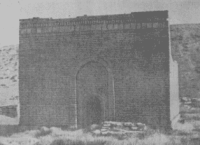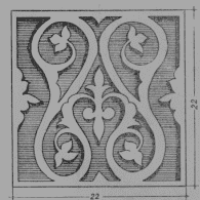You are here
Tulek mausoleum.


Historical sights of Ulytau.
“The dome in these monuments is an important architectural form and the main structure of the ceiling. Its construction, like the portal, was the central task of the architect. In portal-dome structures, the dome was displayed in a single shell, with the exception of the mausoleum of Joshi Khan and some other monuments of Southern and Western Kazakhstan.
Georgy Gerasimovich Gerasimov.
Mausoleums in vicinity of Zhezkazgan.
About 10 kilometers from the city of Novy Dzhezkazgan, near the Kara-Kengir River, there is the Tulek mausoleum. It is located at the foot of a large hill and is oriented to the southwest. According to the composition, this is a portal-dome structure with a very poorly developed peshtak portal.
Instead of the traditional powerful lancet arch with a deep niche in the middle, a small and shallow niche with dimensions of 0.40 x 2.00 meters in plan and 2.83 meters in height is displayed. It is decorated with a weak semi-circular arch, the archivolt of which is made in half a brick.
In the depths, in its back wall, there is an entrance to the mausoleum in the form of an arched opening measuring 0.72 x 1.56 meters. The front wall, like the side walls, is simply designed. It does not have complex architectural elements.
he surface of the walls is slightly enlivened, except for the thread and the entrance opening, with a small frieze of decorative tiles and two narrow belts stretched along it - above and below in the form of a zigzag brickwork.
The upper architectural belt is made twice as wide as the lower one, which visually slightly lightens the laying on top. The width of the frieze is 23 cm, therefore the tiles are made square, the dimensions of their sides are 23 x 22 cm.
Tiles - carved, ceramic. The drawing on them is displayed in the form of a complex floral ornament with a shallow relief. This frieze is stretched not only along the main facade, but also along the side ones, where there are no lower belts of zigzag masonry.
Through the entrance we get inside the mausoleum - into the chamber. Here, too, architectural elements and details are very modestly applied. At first glance, the interior resembles the design of the Alasha Khan mausoleum in miniature: almost the same arch profiles, drawn above the niches in the walls and in the corners, the same constructive brick stalactites in two tiers in the corners of the octahedron to go to the round domed drum, the same method of wedge-radial masonry on a spherical dome, etc.
The imitation of the Alasha-Khaya mausoleum is noticeable not only in individual architectural techniques and details, but also in the composition of the plan, the inner outline of which is 4.95 x 4.97 meters. According to external measurements, it is a rectangle (7.00 x 7.45 meters), close to a square.
Some increase in the size of the longitudinal side occurred due to the thickening of the front wall, in which the entrance niche is arranged. By volume, this mausoleum is a small single-chamber structure topped with a spherical dome.
The height of the preserved part of the peshtak is 4.98 meters, which, probably, was originally a little higher than this mark, since relatively little damage occurred on it. The cornices on the peshtach part and the parallelepiped of the main volume of the chamber were mostly damaged.
The dome was also badly damaged, the entire top of which collapsed. The monument is made of dark red baked brick, which has basically the same dimensions - 26 x 26 x 5.5 cm, but there are also other half sizes.
Brickwork was done satisfactorily, on clay mortar without careful dressing of the seams between the rows. Structurally, the whole structure is made of brick, nowhere is wood used. In contrast to the monuments discussed above, here, not brick with brick rubble, but limestone (marl) on clay mortar was used for the foundation, and a small plinth was made of stone and brick, which prevented premature destruction of the building.
Inside the chamber, on the ground, a brick floor was made in one row “flat” and two sagans were erected over the graves of those buried here. The sagans have now been demolished and the bricks have been dismantled for other purposes.
According to the stories of some local residents, this building was erected about 150 - 175 years ago, that is, in the second half of the 18th century. This seems quite justified, judging by the type, stylistic features and the state of the building today.
Firstly, the type of portal-dome structures with low peshtaks was still preserved in the XVIIIth century, secondly, stylistic techniques in the laying of arches, constructive stalactites (cellular masonry), domes, in the arrangement of the frieze belt on the facades, practiced in the construction of mausoleums in the XIIIth - XIVth centuries, were still traditionally copied in the XVIIIth century, but not quite successfully and often in a distorted way thirdly, in the manufacture of bricks, old patterns and sizes have been preserved,
fourthly, ceramic tiles have good, clear relief patterns of floral ornament, which were also used in other buildings of the XVIth - XVIIIth centuries, fifthly, historically this period, i.e. the second half of the XVIIIth century, could contribute to the emergence of such structures in these areas because then the Kazakh tribes of the Middle Zhuz (Orta-zhuz) were concentrated here, crowded out by the Dzungars.
The economically stronger representatives of the feudal-bai elite could build this mausoleum on the grave of their revered kinsman.
At present, this building is in a satisfactory condition, despite the existing destruction in the dome and peshtach parts, cornices and the floor inside the mausoleum. Out of reverence for the mausoleum, burials have been and are now being made around it, which are decorated with small mausoleums or grave structures in the form of a sagan or mounds.
Tulek Mausoleum interests us as a monument of its era. Its study helps to reveal the history and development of Kazakh national architecture based on folk architecture. There is no doubt that it also has a certain historical and architectural value.
Authority and photos by
Georgy Gerasimovich Gerasimov. "Monuments of architecture of the Kara-Kengir river valley in Central Kazakhstan". Publishing house of the Academy of Sciences of the Kazakh SSR. Alma-Ata. 1957







